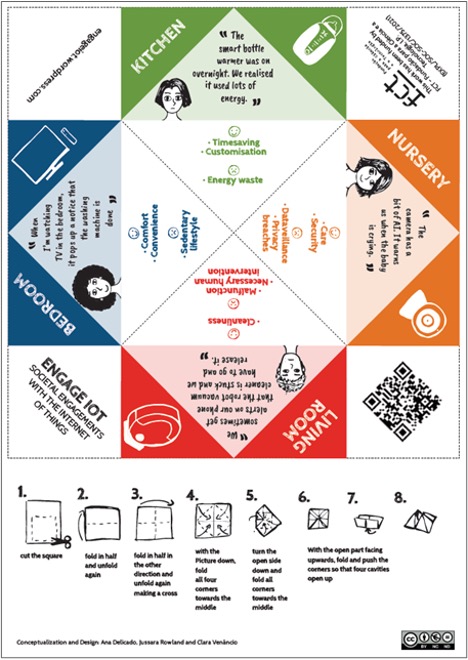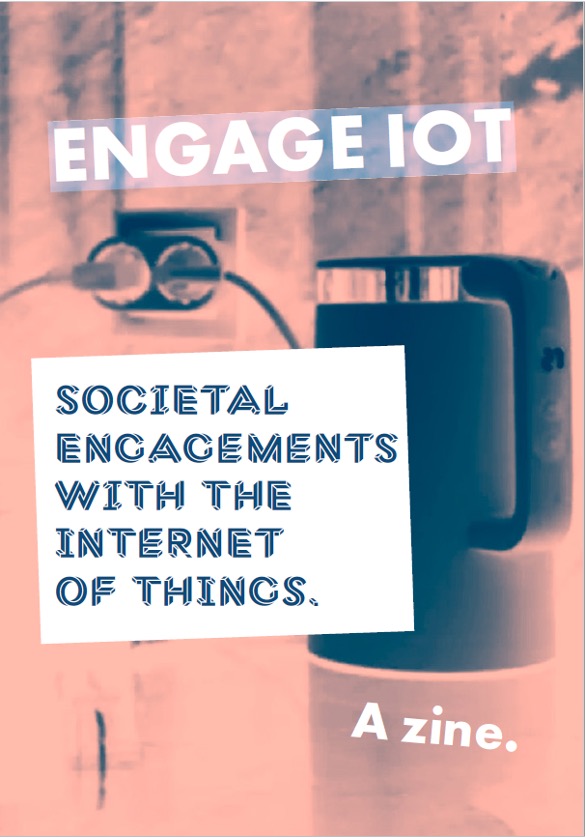Zines as communication tools to engage the public in debates about technology
Jussara Rowland and Ana Delicado11/25/2024 | Reflections
Engaging the public in critical conversations about technology presents a key challenge for researchers in STS and related fields. We argue that zines are a valuable, yet under-utilized, tool for achieving this goal.
What are zines?
Zines, a term derived from fanzines, are unofficial publications produced independently, often by hand, on a variety of topics. Originating in the 1930s among science fiction enthusiasts, zines gained success from the 1970s in the punk and alternative music activist movements, and later, in the 1990s through feminist movements like Riot Grrrl. Traditionally associated with DIY cultures and social and artistic movements, the main function of zines is to disseminate ideas and share information outside conventional circuits challenging dominant cultural narratives and bypassing institutional gatekeeping mechanisms. Zines are characterized by their multimodal and flexible nature, encompassing a wide variety of formats, ranging from simple, photocopied pamphlets to more elaborate, hand-crafted editions. This eclecticism is central to zines' appeal, embodying a DIY ethos that reflects their commitment to accessibility and inclusivity.
Zines in academia
In academia, the unique characteristics of zines make them particularly relevant for knowledge production and dissemination, including within the context of Science and Technology debates. Their informal nature challenges established epistemic hierarchies, offering a way to rethink who can produce and share knowledge. This aligns with the core values of STS, which emphasize inclusivity and the democratization of knowledge. Additionally, zines foster more participatory forms of knowledge creation, making space for often marginalized or underrepresented voices. Their flexible format enables them to circumvent conventional academic constraints, offering an alternative to traditional forms of scholarly communication. Furthermore, their multimodality enriches discussions on technology by presenting diverse, often visual, methods for conveying complex ideas.
Zines can serve as primary sources, offering firsthand accounts and personal narratives for scholarly research. In qualitative studies, they can also be used as a method of research or analysis, offering participants a creative, hands-on medium that encourages individual expression. This approach captures lived experiences in ways that might not emerge through more conventional methods, allowing for a richer, more nuanced exploration of personal perspectives. Additionally, zines are powerful teaching tools, engaging students in ways that foster critical thinking, creativity, and personal reflection. They help bridge the gap between academic theories and personal and societal issues, making learning more dynamic and participatory.
Zines also serve as an effective means of disseminating research results on topics related to STS. Relevant examples include the zines ‘AI for Whose Good?’, by Sophie Wang and Taylor M. Cruz, ‘Getting into Fights with Data Centres’, by Anne Pasek, or Prototypes for a Department of Umbrology, by Santiago Orrego and Tomás S. Criado. In the field of science communication, Emily Dawson made her book ‘Equity, Exclusion and Everyday Science Learning’ more accessible by collaborating with Sophie Wang to create a zine version.
The zine format, combined with the ease of printing, makes them an accessible form of critical expression and reflection, allowing researchers to share content and personal reflections outside the parameters and constraints of traditional academic publication formats. In addition, zines also have the advantage of making academic content more accessible to populations that do not read academic publications, while also making it possible to address more targeted themes and localized audiences. Notably, zines have also been used as foundational formats for conferences, such as the zine-based DIY Methods conference, now in its third edition, or as reflective device for academic events, like the ICT4S Zine 2024 on sustainability and Information and Communication Technologies.
The growing popularity of zines has led to the creation of numerous digital repositories and archives that collect zines from different periods and fields, including sciences. Examples include the Small Science Collective and, more recently, the GEOZONe - Geography Zine Organising Network - a transnational collective archiving zines and print ephemera on topics such as decolonizing the university, spatial politics, and critical geographic methods.
While zines offer significant advantages in terms of accessibility, flexibility and inclusivity, it is important to acknowledge their limitations to avoid overstating their promises. Their informal, alternative format may alienate those unfamiliar with zine culture, and their often niche, ephemeral nature can make them less suitable for widespread dissemination. Thus, while zines hold intrinsic value as tools for creative expression and knowledge sharing, their impact may sometimes be more focused and targeted rather than broad-reaching.
A project zine
In our country (Portugal), the tradition of zines is relatively limited. During the countercultural movements of the 1960s and 70s, the country was under the final years of a repressive regime, and social movements were largely silenced. It was only with the arrival of democracy in 1974 that alternative media, including zines, emerged as platforms for dissent and self-expression, particularly with the rise of punk culture in the late 1970s. In the 1980s, punk fanzines expanded, promoting both music and social critique, while the 1990s saw diversification into new subgenres and issues like women’s rights, drug use, veganism and animal rights. Despite the digital shift in the 2000s, printed fanzines remained significant, blending nostalgia, local activism, and underground culture.
However, we found little evidence of academic zines yet. The scientific system in Portugal only began to accelerate in the 1990s and beyond. Although science communication has developed significantly, traditional publication formats, such as books and magazines, are declining whereas digital mediums (blogs, social media) are dominant. The ‘power of print’ has yet to be rediscovered.
Engage IoT - Social Engagements with the Internet of Things was an exploratory research project, of which one of the authors of this post was PI and the other a team member, funded by The Portuguese Foundation for Science and Technology that was carried out at the Institute of Social Sciences of the University of Lisbon between 2022 and 2023. The central aim of this project was to understand how social actors (producers, consumers, regulators) engage with a new type of technology (Internet of Things - IoT), from the macro level of socio-technical imaginaries to the micro level of usage practices.
Alongside academic publications, in this project we have developed a dissemination strategy to reach further afield, to those who design these technological products, those who regulate them, those who use them; as well as those who are interested in technology and its social aspects. To this end, in collaboration with a videographer we made a short video and in collaboration with a sociologist/designer we made a research brief (in Portuguese). We also experimented with new publication formats that would allow for even greater reach in terms of dissemination. We opted to make a leaflet (in the format of a fortune-teller) and a zine. In both cases, digital versions and printable versions were made, so that they could circulate online but also could be made available in physical form for in-person events.

Figure 1. Project leaflet in the shape of a fortune teller [Image credit: Authors and Clara Venâncio] Creative Commons license, Attribution-Non-commercial-Noderivatives
The zine begins with three basic concepts that shape the theoretical architecture of our research (Internet of Things, socio-technical imaginaries and social practice) and a brief explanation of the zine's intentions. In two pages, we introduce a methodology capable of articulating these concepts, demonstrating the zine as part of a dissemination strategy. Next, we connect this methodological intervention to the IoT ecosystem and its users. Then we delve into three topics that gave us the most concern when studying this technology: the risks and benefits, the environmental impact and the gender dimension. At the end, we reflect on the zine itself and introduce ourselves. As illustrations, we have drawings by the zine designer, Clara Venâncio, quotes from interviews, headlines from newspaper articles and photographs.

Figure 2. Zine cover [Image credit: Authors and Clara Venâncio]Creative Commons license, Attribution-Non-commercial-Noderivatives
The option to write the zine in English both widened and narrowed its potential impact for engaging the public. On the one hand, it allows us to join the international debate mentioned above on experimenting with this format, to be read beyond national frontiers, to follow in the footsteps of our inspirators. On the other hand, our English language zine may not generate much discussion with local publics, unless it is translated (an option still on the cards).
Up until now, we uploaded the zine to an international repository and presented it in both a local science communication conference and an international STS conference. In the former, the zine was met with considerable enthusiasm, mostly due to the novelty of the format. In the latter, the audience was far more familiar with zine making, and consequently more interested in the art/science collaboration behind it.
So, in fact, the role of this zine in engaging the public in debates about technology remains to be tested ‘in the real world’. We learned a great deal in making it, but the “proof of the pudding” is in showing it to the intended audience, non-specialists who may be potential users of the technology and unaware of its implications.
Concluding remarks
Although our small experiment in producing a zine as a way of disseminating research results is undoubtedly quite limited, we expect that zines will become increasingly common in STS. Dissatisfaction with traditional academic publishing is growing (predatory journals, AI assisted paper mills), research assessment is being reoriented towards open science and social impact, novel art-science collaborations in STS are growing. Zines offer a flexible, creative and democratic opportunity for engaging “extended peer communities” in producing, debating and disseminating research, that is particularly appealing to such a reflexive, critical community as STS scholars. The emergence of digital zines, or ezines, further raises questions about how they might produce new socio-technical networks by enabling connections that transcend specific scenes or contexts, connect with wider audiences, and create new forms of engagement that are often less constrained by geographical or institutional barriers. Whether zines will catch on in Portugal is less clear. As a semi-peripheral scientific system, it is far riskier to depart from conventional forms of research communication and dissemination. But since necessity is the mother of invention, lack of resources may push Portuguese researchers “out of their comfort zones”and into the wonderful world of zine creation.
Jussara Rowland is a Research Fellow at the Institute of Social Sciences of the University of Lisbon (Portugal). Her current research interests include the use of participatory and creative methods, the impact of digital media on contemporary societies, and science communication.
Ana Delicado is a Senior Research Fellow at the Institute of Social Sciences of the University of Lisbon (Portugal). She is a sociologist by training and works mainly in social studies of science and technology.
Published: 11/25/2024
